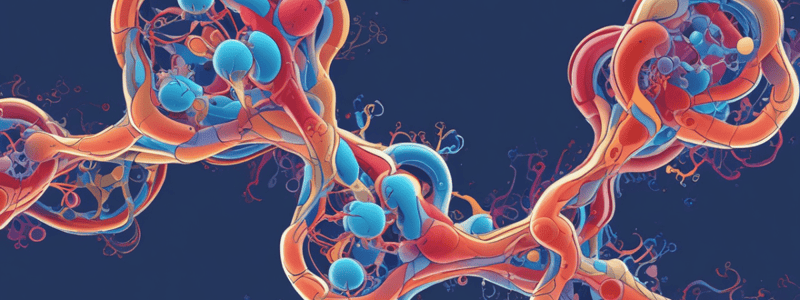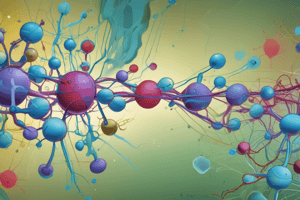Podcast
Questions and Answers
What is the composition of an enzyme?
What is the composition of an enzyme?
- Metal + coenzyme
- Protein + cofactor
- Protein + metal (correct)
- Protein + coenzyme
What is the primary function of enzymes in the body?
What is the primary function of enzymes in the body?
- To synthesize ATP
- To replicate DNA
- To catalyze chemical reactions (correct)
- To transport molecules across cell membranes
What is the role of a coenzyme in an enzyme-catalyzed reaction?
What is the role of a coenzyme in an enzyme-catalyzed reaction?
- To increase the temperature of the reaction
- To carry electrons or hydrogen atoms (correct)
- To bind to the substrate
- To decrease the pH of the reaction
What is the term for the site on an enzyme where interaction with the substrate takes place?
What is the term for the site on an enzyme where interaction with the substrate takes place?
What is the term for the protein part of an enzyme?
What is the term for the protein part of an enzyme?
What is the characteristic of enzymes that allows them to act upon specific substrates?
What is the characteristic of enzymes that allows them to act upon specific substrates?
What is the name of the enzyme that catalyzes the hydrolysis of peptide bonds in proteins?
What is the name of the enzyme that catalyzes the hydrolysis of peptide bonds in proteins?
Which of the following is an example of an exoenzyme?
Which of the following is an example of an exoenzyme?
What type of enzyme catalyzes the breakage of bonds without catalysis?
What type of enzyme catalyzes the breakage of bonds without catalysis?
What is the optimum pH range for most enzyme activity?
What is the optimum pH range for most enzyme activity?
What is the term for the active form of an enzyme?
What is the term for the active form of an enzyme?
What is the term for an enzyme that consists of a protein and a non-protein component?
What is the term for an enzyme that consists of a protein and a non-protein component?
What is the role of enzymes in muscle contraction?
What is the role of enzymes in muscle contraction?
What is the International Union of Biochemistry (IUB) responsible for?
What is the International Union of Biochemistry (IUB) responsible for?
What type of enzyme catalyzes the formation of an isomer of a compound?
What type of enzyme catalyzes the formation of an isomer of a compound?
What is the characteristic of enzymes that allows them to be effective in small quantities?
What is the characteristic of enzymes that allows them to be effective in small quantities?
Flashcards are hidden until you start studying
Study Notes
Enzymes
- Enzymes are proteins that act as catalysts, speeding up chemical reactions without undergoing any change themselves.
- All enzymes are proteins, but not all proteins are enzymes.
- Enzymes are required in very small quantities.
- Each enzyme is very specific and only attaches to one type of molecule, known as its substrate.
- Enzymes possess an active site, where interaction with the substrate takes place.
Properties of Enzymes
- Catalytic property: a small amount of enzyme is enough to break large molecules down into smaller molecules.
- Specificity: enzymes are very specific in action, with one enzyme acting only on a particular substrate.
- Reversibility: most reactions catalyzed by enzymes are reversible.
- Sensitivity to temperature: enzymes are thermolabile or very sensitive to heat and temperature.
- Specificity to pH: enzymes show maximum activity at an optimum pH of 6-8.
Functions of Enzymes
- Essential for respiration, digestion of food, DNA replication, muscle contraction, and nerve function.
- Store and release energy (ATP).
- Create larger molecules from smaller ones.
- Hormone production.
- Transporting materials around a cell.
Sources of Enzymes
- Endoenzymes: function within cells, most enzymes are this type. Example: metabolic oxidase.
- Exoenzymes: liberated by cells and catalyze reactions outside the cell. Examples: digestive enzymes (amylase, lipase, protease).
Chemical Composition of Enzymes
- Enzymes may consist of:
- Protein only. Examples: pepsin, trypsin.
- Conjugated protein (holoenzyme), consisting of:
- Protein + Co-Enzyme.
- Protein + prosthetic group.
- Protein + metal.
Coenzymes and Cofactors
- Coenzymes: organic non-protein molecules that bind to the enzyme and participate in the reaction by carrying electrons or hydrogen atoms.
- Cofactors: non-proteinous substances that associate with enzymes and are essential for their functioning.
- Holoenzyme: consists of Apoenzyme + prosthetic group.
- Apoenzyme: the protein part of the enzyme.
- Prosthetic groups: cofactors tightly bound to an enzyme at all times. Example: FAD.
Zymogen and Enzyme Nomenclature
- Zymogen: the inactive form of an enzyme. Example: pepsinogen → HCl → pepsin (active).
- Enzyme nomenclature:
- Trivial name: such as trypsin and pepsin.
- Adding suffix "ase" to the substrate, such as maltase and lactase.
- International Union of Biochemistry (IUB) systematic name, indicating:
- Substrate acted upon.
- Coenzyme involved in the reaction.
- Type of reaction catalyzed.
Classification of Enzymes
- Oxidoreductases: catalyze oxidation and reduction reactions. Example: pyruvate dehydrogenase.
- Isomerases: catalyze the formation of an isomer of a compound.
- Transferases: catalyze the transfer of a chemical group from one to another compound. Example: transaminase.
- Hydrolases: catalyze the hydrolysis of a bond. Example: pepsin.
- Lyases: catalyze the breakage of bonds without hydrolysis. Example: aldolase.
- Ligases: catalyze the joining of two molecules. Example: DNA ligase.
Studying That Suits You
Use AI to generate personalized quizzes and flashcards to suit your learning preferences.




